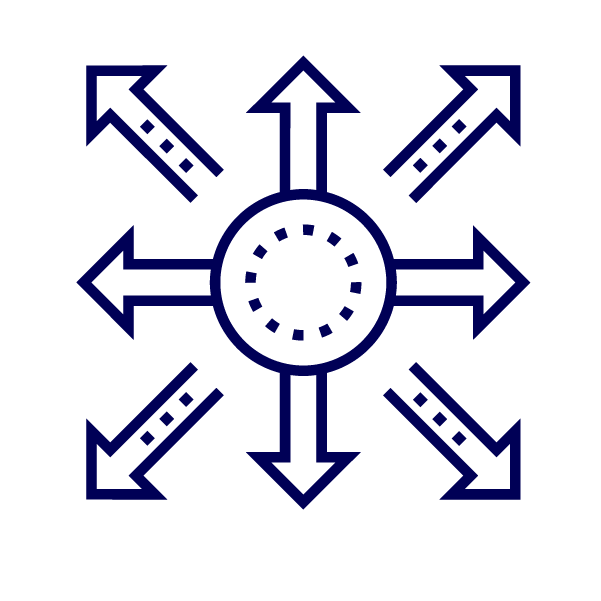Outcome-Driven Process
Strategy
Strategically partner to align mission objectives
Design
Design collaboratively to drive innovation
Execution
Execute with efficiency and effectiveness
Perform
Performance optimization
A CX Partner, supporting your journey
ROI Realized
Federal agencies like yours require an integrated approach to maximizing investments and holistic solutions aligned to mission requirements. CX brings efficiency and effectiveness to the public sector!
Design thinking provides for a multi-disciplinary approach to solving problems through collaboration.
Disruptive innovation provides a framework for identifying opportunities, resource allocation, jobs to be done and more.
+
Designovation integrates the two for a comprehensive methodology that leverages the strengths of each in a tailored manner.
=
OUR APPROACH IS:
Human-Centered
Design-Oriented
Disruptive
Integrated
Multidisciplinary
OUR APPROACH IS: Human-Centered Design-Oriented Disruptive Integrated Multidisciplinary
Applicable NAICS Codes
541490: Other Specialized Design Services
518210: Data Processing, Hosting, and Related Services
541618: Other Management Consulting Services
541690: Other Scientific and Technical Consulting Services
541611: Administrative Management and General Management Consulting Services
541512: Computer Systems Design Services
541519: Other Computer Related Services
541613: Marketing Consulting Services (Includes Customer Experience)
541430: Graphic Design Services
541820: Public Relations Agencies
541511: Custom Computer Programming Services
541690: Other Scientific & Technical Consulting Services
Applicable Product & Service (PSC) Codes
-
DA01 – IT & Telecom – Business Application/Application Development Support Services (Includes User Research, Human Centered Design, Customer Experience (CX))
DA10 – IT & Telecom – Business Application/Application Development Software As A Service
DD01 – IT & Telecom – Service Delivery Support Services; ITSM, Operations Center, Project/PM (Labor)
DE01 – IT & Telecom – End User: Help Desk; Tier 1-2, Workspace, Print, Output, Productivity Tools (Labor)
DF01 – IT & Telecom – IT Management Support Services (Labor)
-
R406 – Support – Professional: Policy Review/Development
R408 – Support – Professional: Program Management & Support
R410 – Support – Professional: Program Evaluation/Review/Development
R422 – Support – Professional: Market Research/Public Opinion
R426 – Support – Professional: Communications
R431 – Support – Professional: Human Resources (Includes Employee Expe-rience)
R499 – Support – Professional: Other
R702 – Support – Management: Data Collection
R708 – Support – Management: Public Relations
R710 – Support – Management: Financial
R799 – Support – Management: Other
-
T001 – Photo/Map/Print/Publication – Arts/Graphics
T013 – Photo/Map/Print/Publication – Technical Writing

Download my capabilities statement or contact us
Designovation leverages the principles of design thinking and theories of disruptive innovation to tailor solutions that deliver tangible value.
-

Strategic Planning: Paving the path for mission success
Your strategy is undefined and/or internal operations are not aligned. You likely have options and must choose the best one to meet mission requirements on time and within budget. Your organization needs focus and Designovation can bring that! We facilitate strategy formulation, align internal decision-making and operations to your strategy, spurring momentum and achievement of goals.
-

Customer Experience (CX): Improve service delivery
Your organization’s Customer Experience (CX) can’t be taken for granted. President Biden’s Executive Order on Transforming Federal Customer Experience and Service Delivery to Rebuild Trust in Government & OMB’s Circular No A-11 Managing Customer Experience and Improving Service Delivery both acknowledge the need for improvements, day by day, interaction by interaction, and within every channel. You need a CX that is exemplary, seamless and effortless while gleaning customer insights from data and enhancing omni-channel processes to better manage your customer’s end-to-end journey. Designovation can help you achieve that!
-

Data Analytics: Drive Informed Decision-Making
Your organization requires data-driven insights to enhance decision-making, improve operational efficiency, and drive mission success. We leverage advanced analytics, artificial intelligence (AI), machine learning (ML), and business intelligence (BI) tools to transform raw data into actionable intelligence. Our data analytics capability renders enhanced performance management, risk management, workforce analytics and Customer Experience (CX) analytics, all of which drive operational efficiency, mission alignment, regulatory compliance and innovation.
-

Portfolio, Program & Project Management: Cascading levels of management to meet business requirements
If you have a portfolio of management and IT programs that require the right balance of centralized and decentralized support, you are not alone. In order to successfully deliver on complex business requirements, you need an integrated, modular approach to establishing and managing your portfolio. Designovation provides the necessary standards, processes and discipline with the right level of autonomy embedded in the framework. Take a look at our case study on successful portfolio management!
-

Grants Management & Outreach: Optimize your Portfolio’s Performance
As a grant making organization, you provide funding externally to meet mission critical needs. You have a grant portfolio that must be managed proactively to avoid compliance issues, ensure that programs are aligned with strategic objectives and performance is measured. Designovation brings extensive grants management experience that improve performance utilizing best practices combined with an understanding of statutes and regulations. Check out our GrantsCX Solution!
-

Strategic Communications: Mission Driven Messaging
Your communication channels have multiplied and audiences are subdivided internally and externally; competition for their attention is growing intense. If you are looking for a deep understanding of stakeholder needs and motivations in order to engage the right audiences through the right channels with the right message, Designovation is your partner of choice! We craft and execute agile communications and change campaigns throughout your digital media framework to drive awareness and engagement as well as generate insights to inform strategy and initiatives! If your organization is undergoing constant change, you need Designovation. We work to reduce or eliminate the negative effects caused by change. Embedding best practices, we help build a culture that expects, embraces and thrives on change to achieve desired results.








